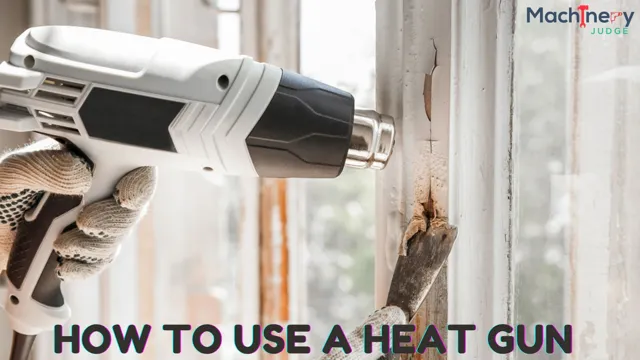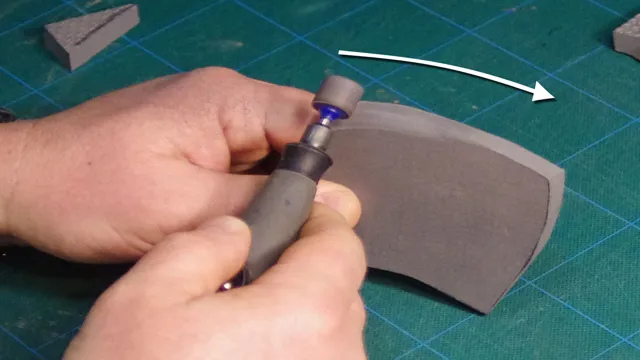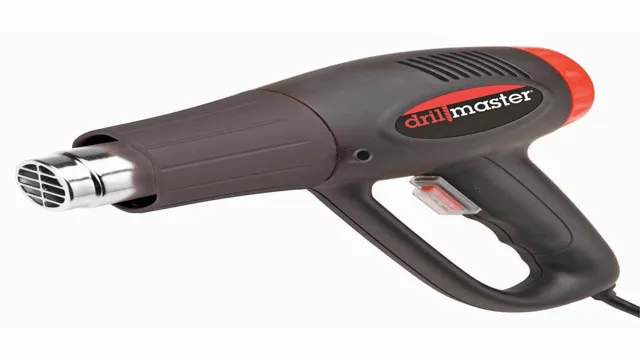
Have you ever found yourself in need of heat shrink tubing and wondered if you have all the necessary tools? One common query is whether a heat gun is needed for heat shrink tubing. The short answer is: yes, it is essential. But don’t worry, it’s not as complicated as it may seem.
A heat gun is a handy tool that helps shrink tubing wrap around wires and cables to create a tight seal. Without it, heat shrink tubing may not fit snugly and could even damage the items you’re trying to protect. Think of it like baking a cake – you need an oven to make it properly, and in the same way, you need a heat gun for heat shrink tubing.
In this blog, we’ll explain why a heat gun is necessary for the process, and how to use it effectively to create a tight, snug seal. So, let’s dive in!
What is Heat Shrink Tubing?
Heat shrink tubing is a handy tool used in many DIY and industrial applications. It provides convenient insulation and protection for various electrical and mechanical components. However, to use heat shrink tubing, you need a heat gun or a hair dryer to shrink the tubing onto the desired object.
The heat gun melts the tubing’s internal adhesive layer, making it shrink and wrap around the object, creating a secure and waterproof seal. Therefore, it is necessary to have a heat gun to apply heat shrink tubing effectively. Trying to shrink the tubing with an open flame or other heat sources can be dangerous, causing burns, melting, and potential fires.
So, if you plan to use heat shrink tubing, invest in a heat gun to get the best results.
Definition of Heat Shrink Tubing
Heat Shrink Tubing Heat shrink tubing is a type of plastic tubing that shrinks in diameter and length when exposed to heat. It is commonly used in electrical applications to provide insulation, strain relief, and protection against abrasion, dust, and moisture. The tubing is made of various types of polymer materials, such as polyolefin, PVC, and fluoropolymer, that possess different thermal, electrical, chemical, and mechanical properties.
The tubing is available in different sizes, colors, and shrink ratios to fit different wire and cable diameters and to provide a tight and secure fit around connectors and terminals. Heat shrink tubing can be applied using a heat gun, oven, or torch, and it can be easily removed or replaced if needed. The advantages of heat shrink tubing include its flexibility, durability, affordability, and ease of use, as well as its ability to conform to complex shapes and contours.
It is widely used in automotive, aerospace, marine, industrial, and DIY projects, as well as in medical and military applications where safety and reliability are critical.

How Does Heat Shrink Tubing Work?
If you’re wondering if you need a heat gun for heat shrink tubing, the answer is yes. Heat shrink tubing works by using heat to shrink the tubing tightly around the object it’s covering. A heat gun is the best tool to use for this process because it provides the high degree of localized heat needed to activate the tubing’s shrinking process.
Without a heat gun, it’s challenging to achieve the right level of heat intensity, and the tubing may not shrink tightly around the object, leaving gaps and open spaces. A heat gun also allows you to control the amount of heat applied and the direction of the heat to ensure a precise, effective shrink. Overall, a heat gun is an essential tool when it comes to using heat shrink tubing effectively.
Explanation of the Shrinking Process
Heat shrink tubing is a versatile material that is commonly used in electrical and mechanical industries. The process of heat shrinking involves applying heat to a piece of tubing, which causes it to contract and fit snugly around an object. The tubing is made of polymer material that has been cross-linked, which means that it will not melt but rather shrink uniformly when heat is applied.
The heat source can be a heat gun, oven or even a lighter, depending on the size and type of tubing used. The shrink rate depends on the material thickness, final diameter, and the amount of heat applied. Once the tubing has shrunk and the object is covered, it can be cooled, and the tubing will retain its new shape.
Heat shrink tubing is useful for providing mechanical protection, strain relief, insulation, and identification. Its versatility makes it ideal for a wide range of applications, including electronics, automotive, aerospace, and marine industries. Shrink tubing provides a neat and professional finish, and its ability to conform to any shape makes it a must-have for any DIY enthusiast or professional repairman.
Why Use a Heat Gun for Heat Shrink Tubing?
If you want to cover electrical wires and make them water, heat, and corrosion-resistant, then heat shrink tubing is the perfect solution. However, you may be wondering, “do I need a heat gun for heat shrink tubing?” The short answer is yes. While there are other methods you can use to shrink the tubing, a heat gun offers the most controlled and precise application of heat.
Heat guns produce hot air that can be easily directed at the tubing, creating an even heat distribution that shrinks the tubing uniformly. This precise application is necessary for creating leak-proof seals that will protect your wiring from environmental damage. Additionally, heat guns are easy to control, safe to use, and quick to heat, making them a highly efficient tool for working with heat shrink tubing.
So, if you want to get the best results with your heat shrink tubing, investing in a heat gun is strongly recommended.
Benefits of Using a Heat Gun
When it comes to heat shrink tubing, using a heat gun is the way to go. Heat guns provide a plethora of benefits when compared to other heating methods. For starters, heat guns are incredibly versatile, as they can be used for a variety of tasks beyond just heat shrinking tubing.
Additionally, heat guns offer precise and controlled heating, allowing for targeted heating of specific areas. This is particularly important when working with delicate materials or when trying to avoid damaging surrounding components. Furthermore, a heat gun’s adjustable temperature settings make it easy to find the right level of heat for the job at hand.
Ultimately, using a heat gun for heat shrink tubing gives you more control, precision, and versatility, and enables you to achieve professional-grade results every time.
Comparison to Other Shrinking Methods
Heat shrink tubing is a fantastic way to protect, insulate, and organize different wires and cables. However, there are various methods of shrinking that tubing, including using a lighter or a hairdryer. While these methods can work, they pale in comparison to using a heat gun.
The reason for this is that heat guns are specifically designed for this purpose and offer many benefits that other methods do not. For instance, a heat gun provides precise heat control for the perfect shrinkage, and it can heat larger areas at once without taking too long. Additionally, a heat gun doesn’t produce open flames like a lighter, which could be dangerous when working with flammable materials.
Finally, heat guns are comfortable to use, as they tend to be lightweight and ergonomic. Overall, if you want accurate, fast, and safe shrink tubing, it is best to invest in a quality heat gun.
When is a Heat Gun Not Necessary for Heat Shrink Tubing?
If you’re wondering whether a heat gun is always necessary for heat shrink tubing, the answer is no. While a heat gun is the most typical tool used to activate heat shrink tubing, there are situations where other methods will suffice. For instance, if the tubing is relatively small and thin, you can apply heat directly with a lighter or match.
Attach the tubing to a wire or string beforehand so you can hold it without burning your fingers. Another option is to use a heat source like a stovetop or oven, either of which can be effective for larger pieces of tubing. Keep in mind that these alternatives require more careful attention and manual work, and may not produce the same results as a heat gun.
But if you don’t have a heat gun on hand or choose to go without one, know that you can still get the job done with a bit of creativity and caution.
Alternatives to Heat Guns
Heat shrink tubing is a great way to protect and insulate electrical wires and connections, but sometimes a heat gun may not be necessary. There are several alternatives you could try, depending on the situation. One option is using a lighter, which may be suitable for small or narrow tubing.
However, a lighter may cause uneven heating and could lead to damage. Another option is hot water – simply soak the tubing in freshly boiled water for a few moments and it should shrink into place. If you’re worried about water getting into connections, try using a hair dryer instead.
Finally, if none of these options work for you, consider using a butane torch. This method requires more care and attention, but is ideal for larger tubing. Just be sure to move the flame in a circular motion to avoid burning the tubing or your fingers.
Remember that safety is always a top priority, so be sure to wear protective gear and follow manufacturer’s instructions carefully.
Factors That Affect Shrinkage Without Heat Guns
Heat shrink tubing is a popular tool for protecting and insulating wires and cables, but many people assume that a heat gun is necessary for the shrinkage process. However, there are several factors that can affect the shrinkage process without the use of heat guns. One of the most important is the type of tubing being used – some materials will shrink better than others without a heat source.
Additionally, the size of the tubing and the thickness of the material can also have an impact on the shrinkage process. Lastly, environmental factors such as temperature and humidity can play a role in the effectiveness of shrinkage without a heat gun. While a heat gun can certainly speed up the process and ensure a tight fit, it’s good to know that there are other options available for those who don’t have access to one or prefer not to use one.
Conclusion
In conclusion, do you really need a heat gun for heat shrink tubing? It all depends on how you want your final product to look and function. If you want a neatly sealed and protected item with minimal potential for damage, then a heat gun is the way to go. But if you’re satisfied with a more DIY approach and don’t mind a little mess or potential for issues down the road, then you can certainly forego the heat gun.
The choice is yours, but remember, a little extra effort and investment now can save you a lot of headaches and expense in the future.”
FAQs
What is heat shrink tubing used for?
Heat shrink tubing is a type of tubing that contracts in size when heated, and is commonly used to protect and insulate cables, wires and other small parts.
How do I choose the right size heat shrink tubing?
It is important to choose the size of heat shrink tubing that is slightly larger than the diameter of the object you want to protect or insulate. This ensures a snug, secure fit after heat is applied.
Can I use a hairdryer instead of a heat gun for heat shrink tubing?
While a hairdryer can be used in some cases, it is not possible to achieve the same level of heat concentration and control as with a heat gun. This can result in uneven heating and damage to the tubing or object being protected.
Do I need a heat gun for heat shrink tubing?
While a heat gun is not always necessary, it is the ideal tool for shrinking heat shrink tubing evenly and effectively. Heat guns are designed to provide a consistent and concentrated flow of heat, making them well-suited to heat shrink tubing applications.
Can heat shrink tubing be removed or reused?
Heat shrink tubing is generally not designed to be removed or reused. Once it has been heated and shrunk, it is intended to remain in place permanently as a protective or insulating covering.
Is heat shrink tubing waterproof?
Heat shrink tubing can provide a level of water resistance, but it is not inherently waterproof. The level of water resistance provided will depend on the specific type of tubing, as well as the environment in which it is used.
What materials are heat shrink tubing made from?
Heat shrink tubing can be made from a variety of materials, including polyolefin, fluoropolymer, PVC, and silicone. The specific material used will depend on the intended application and the properties required for protection or insulation.







